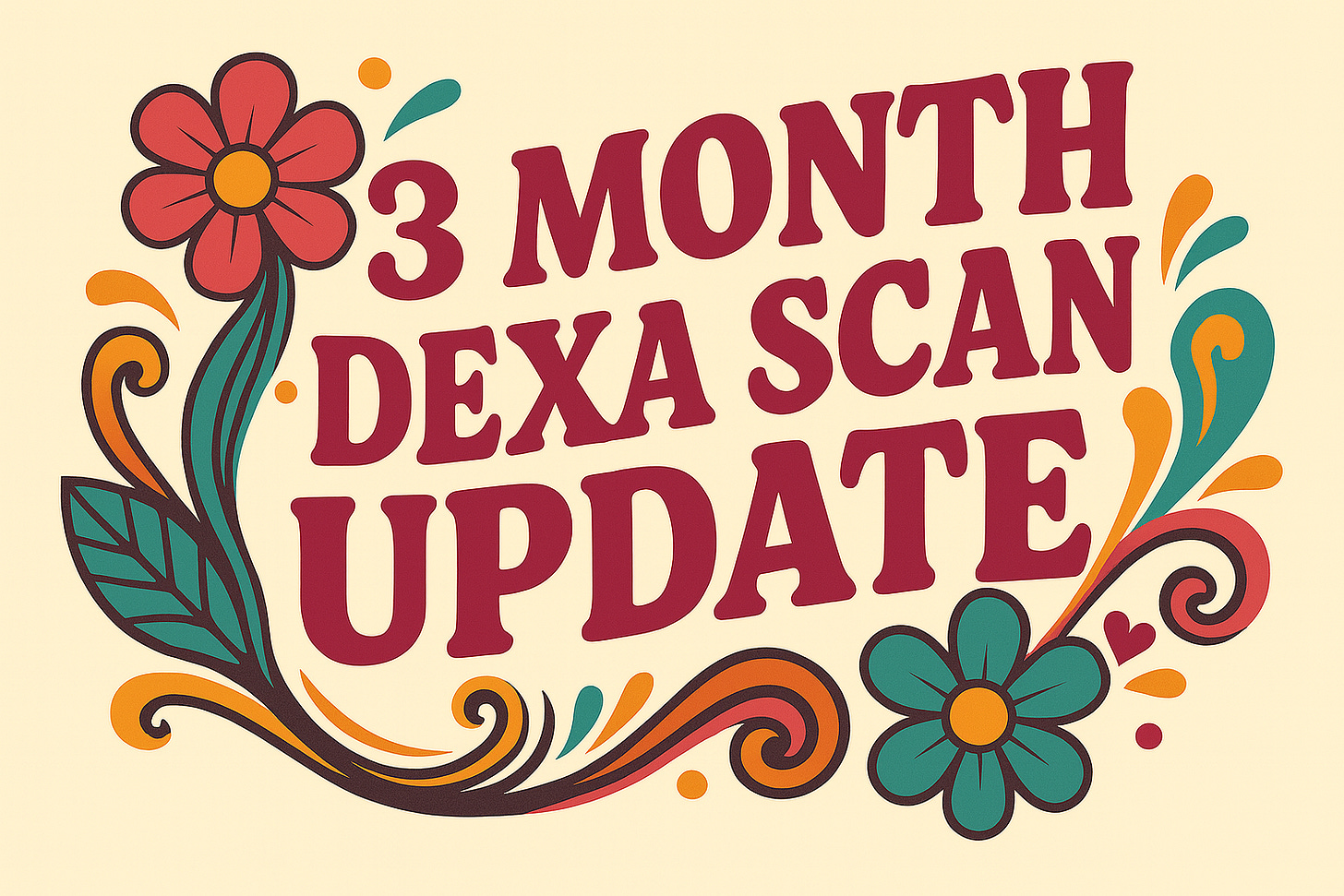My Three Month DEXA Scan update
What My DEXA Scans Are Teaching Me About Body Recomposition During Perimenopause
Earlier in the year, I decided to take a proactive approach to managing and supporting my body for aging well. And in doing so, I decided to have a DEXA scan to get a baseline for where my muscle mass, bone density and fat distribution were at.
Often, we're advised to have a DEXA scan when it's already too late and we've got osteopenia or osteoporosis. By knowing my starting point, I can take steps to prevent and avoid complications as I age. A DEXA scan is a simple, non-invasive way to measure your bone density, muscle mass, and body fat distribution.
Back in June, I wrote about undergoing my first DEXA scan as part of what I referred to as my "rebuild phase."
If you want to read more about that first, you can read it here.
Three months later, I'm back with my 3-month follow-up results from last week, and honestly, I'm still processing what they mean, but it's looking good.
The numbers that matter:
My body fat is down: 36.7% → 33.1% (3.6% decrease)
Fat mass lost: 4.47kg over three months
Muscle mass: Essentially maintained (lost only 295g)
Visceral fat: 124cm² → 92.5cm² (moved from "increased risk" to "normal")
Bone density: Not only maintained but slightly improved
My doctor (an exercise physiologist) called it "80% improvement in metrics over three months."
However, what those numbers don't capture is the entire picture…
The reality behind the results
The past three months weren't a fitness success montage. Some days training felt harder than others, and my consistency with walking was actually worse than before June's DEXA.
Yet my body was still responding positively to the changes I was able to make. The visceral fat reduction alone, moving from "increased risk" to "normal" range, significantly lowers my risk for cardiovascular and metabolic diseases.
That's not vanity metrics; that's health span.
What actually worked
Looking back, a few things made the difference:
Showing up to the gym. Even when training felt hard, I showed up. Maybe my workouts weren't always strong, but on some days they were, and other days I just showed up. Some days, my 100% meant hitting every exercise with energy to spare. Other days, my 100% was dragging myself to the gym and doing whatever felt possible. Both versions got me to these results. My exercise physiologist emphasised progressive overload in strength training.
Professional guidance. This wasn't a DIY experiment. Having someone interpret my scans, adjust my program, and monitor my progress made all the difference between spinning my wheels and actual results. I'm happy to report that, as a weight management coach, most of the guidance wasn't far off from what I have been trained to provide.
Measuring what matters. Tracking visceral fat and muscle mass rather than just scale weight gave me a clearer picture of what was actually happening in my body.
The perimenopause plot twist
Here's what I find most interesting: these improvements happened during perimenopause, when everything we're told suggests our bodies should be working against us. Declining estrogen, slower metabolism, and increased fat storage around the middle are all the things that make midlife women feel like they're fighting uphill.
But my results suggest that with the right approach, we can work with our changing bodies rather than against them. The key seems to be getting specific about what needs attention (hence the DEXA scan) and having professional support to navigate the complexities.
What's next
I have a plan for continuing this momentum, and I'll be sharing more about my overall approach when I hit my 12-month mark in November.
The bigger picture
These three months reinforced something I've been thinking about a lot: the importance of measuring and monitoring during perimenopause rather than just accepting that everything goes to hell after 40.
Gathering baseline data, whether through a DEXA scan, comprehensive blood work, or collaborating with experts, provides a concrete foundation to work with. You're not guessing anymore; you're responding to actual information about your body.
The results also remind me that our bodies are more resilient and responsive than we often give them credit for, even during hormonal transitions. But they also require more intentional support than they did in our 20s and 30s.
If you're considering a DEXA scan or feeling stuck with your health during perimenopause, here's what I'd suggest:
Get baseline measurements before making changes
Work with professionals who understand midlife women's physiology
Focus on body composition, not just weight
Be prepared for non-linear progress
Address energy and nutrition alongside exercise
The conversation I want to have:
Have you noticed changes in how your body responds to exercise and nutrition during perimenopause? What measurements or markers have been most helpful for tracking your health? Are there specific challenges you're facing that feel different from when you were younger?
Hit reply and let me know, I'm always learning from your experiences too.
You may also like…
Why I’m Glad I Got a DEXA Scan Before My 60s
Recently, I had my very first DEXA scan. If you’ve never heard of it, it’s a simple, non-invasive way to measure your bone density, muscle mass, and body fat distribution. I decided to do it because I’m in what I call my rebuild phase after a few years of not feeling great. I’m working on improving my health, strength, and vitality as I edge through per…
How I'm Breaking My Midlife Consumption Addiction (And Why You Might Want To Too)
The algorithm knows exactly how to keep you scrolling. But what if you chose creating instead?








You are an inspiration!
Thanks for sharing! It's interesting to see what affects bone health. Did you change what you ate at all? Or just added in more workouts?